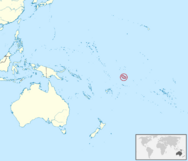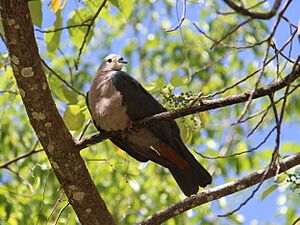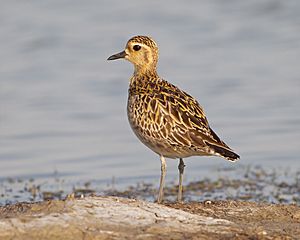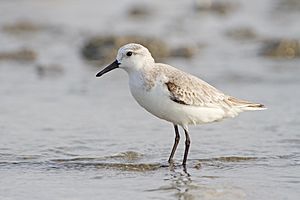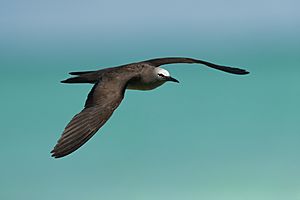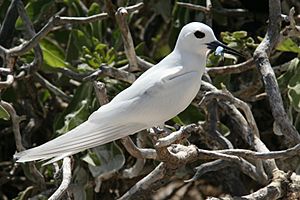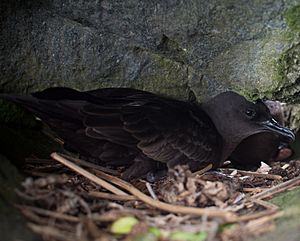List of birds of Tokelau facts for kids
Tokelau is a small group of islands in the Pacific Ocean. It's a special territory of New Zealand. These islands are in a part of the world called Polynesia.
Tokelau is made up of three coral atolls, which are ring-shaped islands. The total land area is very small, about 10 square kilometers (4 square miles).
About 33 different kinds of birds have been seen in Tokelau. One bird, the red junglefowl, was brought there by people. Some ducks, called Anas ducks, also visit the islands at certain times of the year.
The most common birds in Tokelau are the black noddy, brown noddy, and white tern. Thousands of these birds live on each atoll.
Some birds in Tokelau are "near-threatened." This means they could become endangered soon. These include the bristle-thighed curlew, bar-tailed godwit, and flesh-footed shearwater. Sadly, one bird, the Australian masked-owl, no longer lives in Tokelau. It is "locally extinct."
Before people arrived, other birds might have lived in Tokelau. These could have included kingfishers, rails, warblers, starlings, sandpipers, and fruit doves.
Tokelau has a warm, wet climate all year. The average temperature is about 28°C (82°F). It rains a lot, with over 3000 mm (118 inches) of rain each year.
The islands are made of coral rock and small pieces of coral. The soil isn't very rich. The inner parts of the islands have many coconut palm trees. Other tropical trees like Cordia subcordata, Pisonia grandis, Guettarda speciosa, and Pandanus also grow there. Underneath, you might see bird's-nest fern. Closer to the beach, the plants are different because there's very little soil. You can find plants like Scaevola taccada and Morinda citrifolia there.
This list of birds follows a special scientific way of grouping them. It's like a family tree for birds. This helps scientists understand how different birds are related.
We use special tags to tell you more about some of the birds:
- (A) Accidental – This means the bird doesn't usually live in Tokelau. It might have visited by accident, perhaps blown off course by a storm.
- (I) Introduced – Humans brought this bird to Tokelau. It wasn't naturally there.
- (Ex) Extirpated – This bird used to live in Tokelau but doesn't anymore. It might still live in other places around the world.
Pheasants, Grouse, and Allies
Order: Galliformes Family: Phasianidae
This family includes birds like quails, partridges, and pheasants. They are usually plump birds that live on the ground. They have broad, short wings.
- Red junglefowl, Gallus gallus (I)
Pigeons and Doves
Order: Columbiformes Family: Columbidae
Pigeons and doves are birds with strong bodies, short necks, and thin beaks. They have a soft, fleshy part at the base of their beak called a cere.
- Pacific imperial-pigeon, Ducula pacifica
Cuckoos
Order: Cuculiformes Family: Cuculidae
The cuckoo family includes cuckoos and roadrunners. These birds come in different sizes. They have slender bodies, long tails, and strong legs. Many cuckoos are known for laying their eggs in other birds' nests.
- Long-tailed koel, Eudynamys taitensis
Plovers and Lapwings
Order: Charadriiformes Family: Charadriidae
This family includes plovers and lapwings. They are small to medium-sized birds with compact bodies. They have short, thick necks and long, often pointed, wings. You can find them in open areas all over the world.
- Pacific golden-plover, Pluvialis fulva
Sandpipers and Allies
Order: Charadriiformes Family: Scolopacidae
This is a large family of shorebirds. It includes sandpipers, curlews, godwits, and snipes. Most of these birds eat small bugs they find in mud or soil. Some have special beaks that help them find food.
- Bristle-thighed curlew, Numenius tahitiensis
- Whimbrel, Numenius phaeopus (A)
- Bar-tailed godwit, Limosa lapponica
- Ruddy turnstone, Arenaria interpres
- Sanderling, Calidris alba
- Wandering tattler, Tringa incana
Gulls, Terns, and Skimmers
Order: Charadriiformes Family: Laridae
This family includes gulls, terns, and skimmers. Gulls are usually grey or white, often with black on their heads or wings. Terns are generally smaller than gulls. They have more pointed wings and beaks. Many terns also have forked tails that help them fly well. Both gulls and terns can be found near lakes and rivers. Gulls have also learned to live well near people in cities.
- Brown noddy, Anous stolidus
- Black noddy, Anous minutus
- Blue-gray noddy, Anous cerulea (A)
- White tern, Gygis alba
- Sooty tern, Onychoprion fuscatus
- Gray-backed tern, Onychoprion lunatus
- Black-naped tern, Sterna sumatrana
- Great crested tern, Thalasseus bergii
Tropicbirds
Order: Phaethontiformes Family: Phaethontidae
Tropicbirds are thin, white birds that live over tropical oceans. They have very long feathers in the middle of their tails. Their heads and long wings have black markings.
- White-tailed tropicbird, Phaethon lepturus
- Red-tailed tropicbird, Phaethon rubricauda
Shearwaters and Petrels
Order: Procellariiformes Family: Procellariidae
This group includes medium-sized petrels. They have nostrils that are joined together. They also have a long outer flight feather on their wings.
- Southern giant-petrel, Macronectes giganteus (A)
- Bulwer's petrel, Bulweria bulwerii (A)
- Flesh-footed shearwater, Ardenna carneipes
- Wedge-tailed shearwater, Ardenna pacificus (A)
- Christmas shearwater, Puffinus nativitatis (A)
- Tropical shearwater, Puffinus bailloni
Frigatebirds
Order: Suliformes Family: Fregatidae
Frigatebirds are large seabirds. You usually find them over tropical oceans. They can be black and white or all black. They have long wings and tails that are deeply forked. Male frigatebirds have colorful throat pouches that they can inflate. They don't swim or walk much. They also can't take off from a flat surface. They spend most of their time flying and can stay in the air for days!
- Lesser frigatebird, Fregata ariel
- Great frigatebird, Fregata minor
Boobies and Gannets
Order: Suliformes Family: Sulidae
This family includes gannets and boobies. Both are medium to large seabirds that live near coasts. They dive headfirst into the water to catch fish.
- Masked booby, Sula dactylatra (A)
- Brown booby, Sula leucogaster
- Red-footed booby, Sula sula
Herons, Egrets, and Bitterns
Order: Pelecaniformes Family: Ardeidae
This family includes bitterns, herons, and egrets. Herons and egrets are medium to large wading birds. They have long necks and legs. Bitterns usually have shorter necks and are more shy. Birds in this family fly with their necks pulled back.
- Pacific reef-heron, Egretta sacra
Barn-owls
Order: Strigiformes Family: Tytonidae
Barn-owls are medium-sized owls. They have large, flat heads and special heart-shaped faces. They have long legs with slightly curved claws.
- Australian masked-owl, Tyto novaehollandiae (Ex)
See also
- List of birds
- Lists of birds by region


